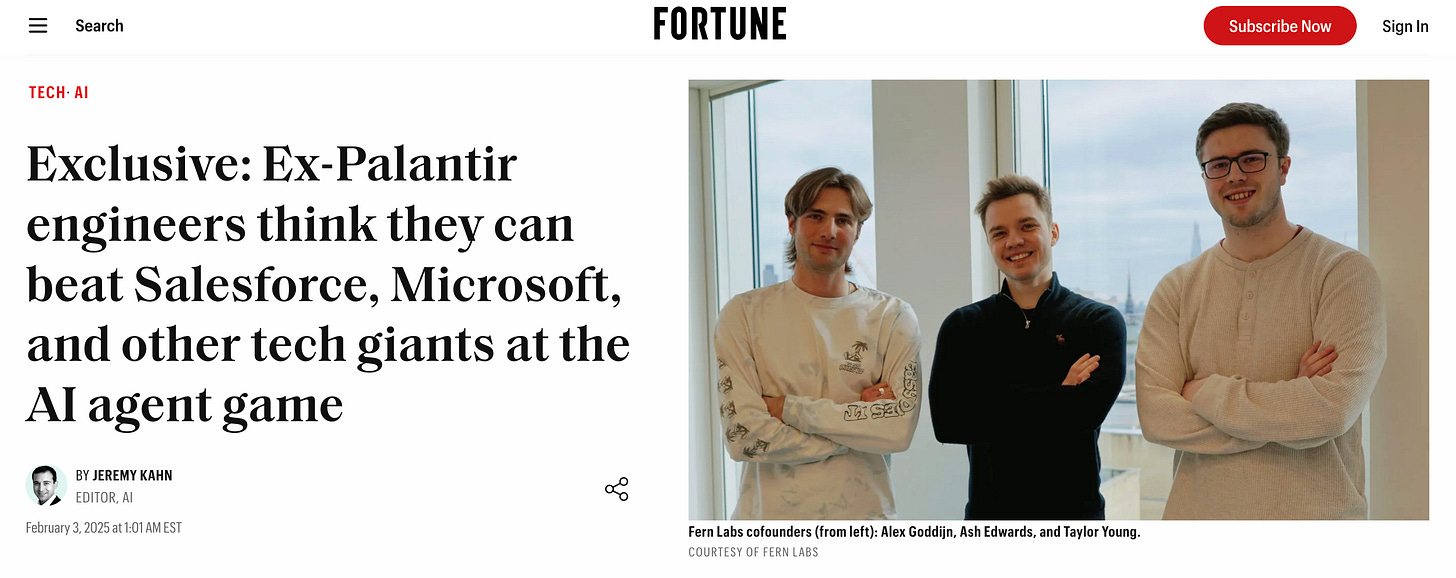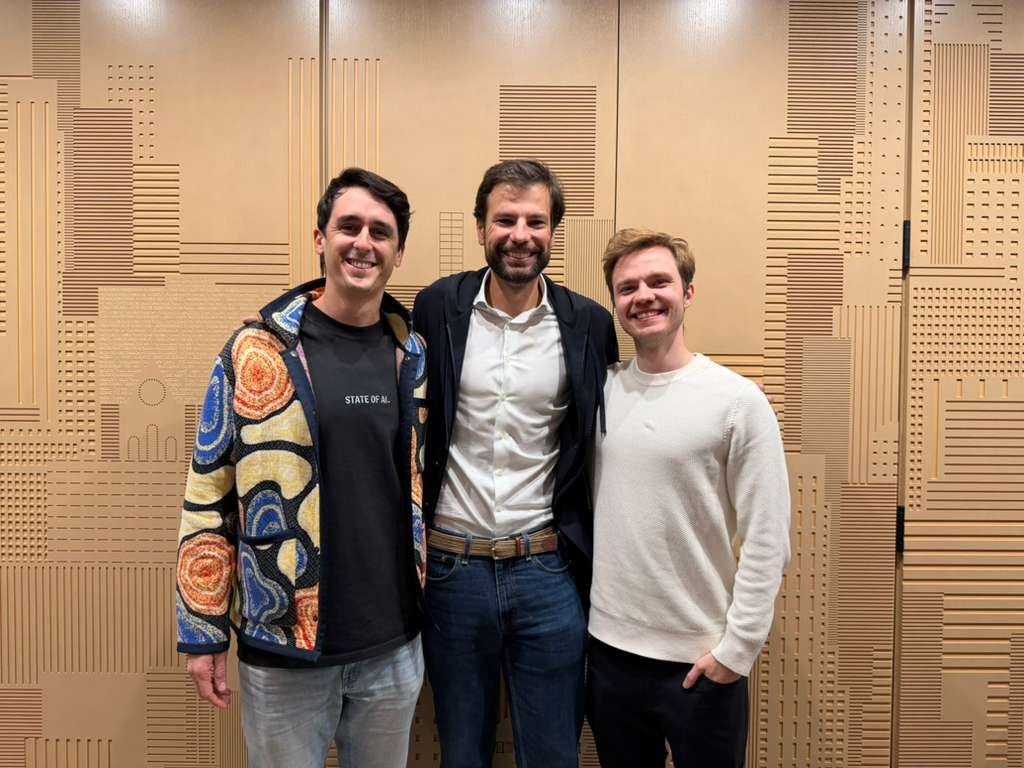Investing in Fern Labs to unlock multi-agent systems
When I first met Ash in late 2024 through a mutual friend at Palantir, Fern Labs was still operating under a codename. Despite the early state of the company, one thing was obvious: Ash had the rare combination of technical depth, velocity, and clarity of product intuition that you only see in the very best AI founders. His colleagues at Palantir described him as someone with exceptional taste, the ability to lock onto the right problems before others see them, and the person who repeatedly pushed the organisation toward generative AI long before it was fashionable. This is exactly the founder phenotype that we look for at Air Street: technical, pragmatic, and customer value-centric.
With Fern, Ash was pushing toward something more ambitious and more precise than yet another agent framework. His goal: to solve long-running, reliable agents by creating an agentic operating system that fused structured reasoning, tool use, and traceability. It echoed many of the ideas I wrote about in Open-endedness is all we’ll need, which argued that the next stage of truly usable AI agents will come from systems that continually generate novelty, self-improve, and orchestrate long-horizon tasks in unpredictable environments. Ash had independently arrived at similar conclusions long before we ever compared notes, particularly the importance of systems that can adapt, iterate, and expand their own capabilities over time.
Over a quick succession of calls and async docs, Ash explained how Fern’s architecture was built around this exact intuition: long-running loops of generation, critique, repair, memory, and tool use that allow agents to improve across episodes rather than simply complete a single task. Indeed, Fern was an early glimpse of the systems that will eventually handle complex, multi-stage real‑world workflows. Succeeding at this mission would be of critical importance to the success of agents in the enterprise.
Without hesitation, Air Street led the entire $3M financing to back Ash before the company had a website, a deck, or a team. Shortly thereafter, Alex and Taylor - two equally talented Palantirians - jumped into Fern and we were off to the races. Here’s what happened next.
From short demos to 10-hour autonomous builds
One of the cleanest ways to understand Fern’s progress is through time horizons of autonomous agent work. Around the time METR published excellent work on measuring how long current agents can run before falling apart, even the best models like Sonnet 3.7 only reliably handled tasks under an hour - a far cry from real-world workflows. Meanwhile, Fern was already pushing well beyond those limits.
In the early months, the team focused on short autonomous builds that were concrete enough to stress-test the system end to end. Fern would spin up several agents with their own virtual machines, access to tools and a product requirement document for what the user wanted Fern to create. Fern agents built products like a remote interviewing tool in roughly three hours of autonomous work, a Slack-style workspace clone with real functionality, and a functional video calling site with screen sharing, recording and no noticeable latency on live cross-continental video calls. Taken together, these showed that Fern could wire together non-trivial features across frontend, backend, and data.
By the time Ash joined us at the Air Street NYC AI meetup in mid-April 2025, Fern was routinely running agents for several hours at a time, up to 10 hours - a feat that the field had not yet demonstrated publicly. In that talk, he showed something important: when you let agents run longer, the quality of the resulting software build compounds. With more time, the same Fern agents produced more polished UIs, discovered and implemented advanced features like search, authentication, and richer workflows that you would normally only expect from a human team iterating over multiple sessions. At a moment when the best public evaluations suggested that agents struggled beyond a few hours of equivalent human work, Fern was quietly demonstrating 5x that horizon in the wild.
The next chapter
In tandem with Fern accelerating its revenue build via a forward deployed motion with large enterprises, frontier labs were expanding their agentic capabilities. It was becoming clear that winning the largest prize in AI - agents that write, maintain and improve all software - requires compounding compute, models, tools, and workflows into a unified development environment. Put another way, a frontier AI company would need Fern, just as Fern would need a frontier AI company.
Meanwhile, poolside - the frontier AI company tackling the most high-stakes deployments - had been pursuing exactly this vision. I’ve been involved with poolside since before its creation and as one of the first investors with Air Street’s first fund. I have seen firsthand how Eiso and Jason built the company from a set of clearly articulated beliefs - including that mastering software development is a viable path to AGI - into a real contender at the frontier.
Following an introduction I’d made between Eiso and Ash, the two companies began exploring what a go-to-market partnership could unlock in each other’s roadmaps. It rapidly became clear that joining forces would help both companies reach their shared roadmap far faster.
What poolside and Fern are building together
Poolside is building one of the strongest full-stack AI companies in the world by uniting the energy, compute, models, and infrastructure needed to run multi-agent systems for complex enterprise workflows under one roof. The Fern team brings a deeply opinionated agentic core - built from first principles and stress-tested on real workloads - into a company with scale, distribution, and compute firepower. Fern’s architecture was built for agent specialization and coordinated long-horizon work - the exact capabilities poolside can scale into a full production environment.
Together, they can move faster on:
Agentic infrastructure that actually scales, not just demos well.
Enterprise-grade traceability and safety primitives, which Fern built from the ground up.
Developer tooling that makes reasoning systems predictable, debuggable, and production-ready.
Integrated model and agent loops, which poolside is uniquely positioned to own end-to-end.
This is the direction the market has been moving toward: a world where model performance, agent reliability, and developer ergonomics form a single continuum. Here, the winners will own that entire stack - a belief I have held for many years.
A word about the AI community Air Street is building
One of the privileges of working in AI for over a decade is seeing how networks of startups, bigger companies, and researchers compound. The opportunity to work with Ash on Fern existed because my network surfaced an exceptional founder when he took the risk to build something new. Poolside exists because that same community has been pushing the frontier of AI capabilities for years.
When these networks work well, moments like this emerge organically: founders meet each other, visions align, and the right strategic move becomes the obvious one. Indeed, the best outcomes don’t happen by accident - they emerge when the right people, the right ideas, and the right timing align. This is one of those moments.
I’m proud to have backed both entrepreneurs early. I’m even more proud to have helped bring them together.
And I’m excited for what they will build next! 👀








👏🏻 👏🏻